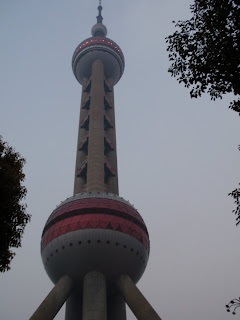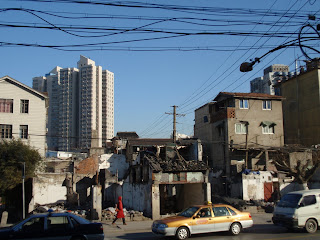 We started our winter trip on Jan. 9 by catching a train for Shanghai. It is a two hour ride and by the time we found out hotel and checked in, it was time to meet our group for lunch. We take our trips with the teachers who are here with the same BYU sponsored China Teachers Program that we are associated with. There are over 70 teachers in the program, but not all travel every trip so we have somewhere between 40 and 60 people in our group. The only time I have seen them all together was in Hong Kong for the manditory mid-winter conference. Other than that they rotate in and out of the traveling.
We started our winter trip on Jan. 9 by catching a train for Shanghai. It is a two hour ride and by the time we found out hotel and checked in, it was time to meet our group for lunch. We take our trips with the teachers who are here with the same BYU sponsored China Teachers Program that we are associated with. There are over 70 teachers in the program, but not all travel every trip so we have somewhere between 40 and 60 people in our group. The only time I have seen them all together was in Hong Kong for the manditory mid-winter conference. Other than that they rotate in and out of the traveling.So here is my impression of Shanghai---many, many tall buildings. Shanghai is the China's largest city and the financial capital of the country. The buildings are quite spectacular in their architecture so I have included pictures that I took as we did our touring. The gold windows on the above tower were amazing. 
This is the Pearl Tower. It is the TV tower for CCTV, China's official television station. The balls symbolize pearls dropping into a jade plate and come from a poem written in the Tang dynasty (610-907 AD). It is four years old and our guide told us it was the 3rd highest building in the world. In good weather, the view from the top must be spectacular. Unfortunately, it was so hazy when we were there that the pictures didn't show much more than the river just below the tower. The best part was the Shanghai municipal history museum in the building at the bottom of the tower. Llife-size models of traditional shops contain lifelike wax people and a wealth of historical information. It was like walking down a Shanghai street 130 years ago.
More interesting buildings. The shapes are quite unique.

Here is good picture of the skyline taken from the Shanghai side of the river. You can see the Pearl tower and a building with a hole in the top. Interesting story behind the latter. It was designed and build by a Japanese firm. If you remember your history, Japan invaded China in 1937 and brutally took over the country. Consequently, there is no love lost between the two countries. The originaly architecture called for a round hole, but the Chinese thought that looked too much like the sun on the Japanese flag. Also, they thought the building looked like a Samauri sword and there was a huge outcry about the symbolism that the Japanese were putting into China. Finally, the plans were changed and a square hole replaced the round one so the Chinese people were calmed down and the construction began.
This building is the Shanghai Museum, an excellent museum with displays of sculputre,calligraphy, Chinese painting, furniture, coins, jade, costumes, and many other things. Because it is modern, the displays are excellent, esay to see, and interesting. For example in the art and calligraphy areas, the display cases are dark until someone walks by. Then the lights turn on to the display and go off again as the person moves on--a great way to protect the ancient works. If you look at the building, it symbolized heaver--the round part, and earth--the square part. Chinese are big into symbolism and the heavens are round and the earth is square. (more about the square earth in a later blog.)

To make way for the new skyscrapers, old buildings and neighborhoods have to go. This is what it looked like across the street from our hotel. You can see the buildings being torn down and see a new high rise apartment building in the background. Shanghai needs someplace to put the population which is now over 20 million people!

Even with all the building and modernization, one can still find sights like this bicycle repair man who just had his tools on the street and people stopped by to get him to fix their bikes.

Every town and city has its gardens and Shanghai was no exception. We visited the Yuyuan Gardens early one morning. It was cold and windy, but still lovely. This is one of the bridges across the water. You will note that it is not straight but has bends in it. That is because evil spirits can only go in a straight line so when people build their gardens, they tended to put crooked bridges rather than straight ones. Superstitions aside, I think the zig-zag lines are much more interesting that a straight line would have been.

The winter holiday in China is actually called "Spring Festival." In the Chinese communities in the US it is called Chinese New Year. China years are divided into lunar months. The lunar new year this year fell on Jan 25, so when we were traveling we saw many of the decorations that the Chinese use to celebrate. Red is the dominant color and the shops and streets were hung with bright red lanterns as you can see in these two last pictures. This is the year of the ox. Everyone who possibly can goes home for the holiday. For example, the dry cleaner whose shop is near our house closed up and was gone for a couple of weeks. He is

This is the Pearl Tower. It is the TV tower for CCTV, China's official television station. The balls symbolize pearls dropping into a jade plate and come from a poem written in the Tang dynasty (610-907 AD). It is four years old and our guide told us it was the 3rd highest building in the world. In good weather, the view from the top must be spectacular. Unfortunately, it was so hazy when we were there that the pictures didn't show much more than the river just below the tower. The best part was the Shanghai municipal history museum in the building at the bottom of the tower. Llife-size models of traditional shops contain lifelike wax people and a wealth of historical information. It was like walking down a Shanghai street 130 years ago.
More interesting buildings. The shapes are quite unique.
The weather cleared out the second day we were in Shanghai, but it was still extremely cold and windy. We plan to go back sometime this spring when it is warmer. There are some other things we want to do--like a boat trip down the river.

Here is good picture of the skyline taken from the Shanghai side of the river. You can see the Pearl tower and a building with a hole in the top. Interesting story behind the latter. It was designed and build by a Japanese firm. If you remember your history, Japan invaded China in 1937 and brutally took over the country. Consequently, there is no love lost between the two countries. The originaly architecture called for a round hole, but the Chinese thought that looked too much like the sun on the Japanese flag. Also, they thought the building looked like a Samauri sword and there was a huge outcry about the symbolism that the Japanese were putting into China. Finally, the plans were changed and a square hole replaced the round one so the Chinese people were calmed down and the construction began.
This building is the Shanghai Museum, an excellent museum with displays of sculputre,calligraphy, Chinese painting, furniture, coins, jade, costumes, and many other things. Because it is modern, the displays are excellent, esay to see, and interesting. For example in the art and calligraphy areas, the display cases are dark until someone walks by. Then the lights turn on to the display and go off again as the person moves on--a great way to protect the ancient works. If you look at the building, it symbolized heaver--the round part, and earth--the square part. Chinese are big into symbolism and the heavens are round and the earth is square. (more about the square earth in a later blog.)

To make way for the new skyscrapers, old buildings and neighborhoods have to go. This is what it looked like across the street from our hotel. You can see the buildings being torn down and see a new high rise apartment building in the background. Shanghai needs someplace to put the population which is now over 20 million people!

Even with all the building and modernization, one can still find sights like this bicycle repair man who just had his tools on the street and people stopped by to get him to fix their bikes.

Every town and city has its gardens and Shanghai was no exception. We visited the Yuyuan Gardens early one morning. It was cold and windy, but still lovely. This is one of the bridges across the water. You will note that it is not straight but has bends in it. That is because evil spirits can only go in a straight line so when people build their gardens, they tended to put crooked bridges rather than straight ones. Superstitions aside, I think the zig-zag lines are much more interesting that a straight line would have been.

The winter holiday in China is actually called "Spring Festival." In the Chinese communities in the US it is called Chinese New Year. China years are divided into lunar months. The lunar new year this year fell on Jan 25, so when we were traveling we saw many of the decorations that the Chinese use to celebrate. Red is the dominant color and the shops and streets were hung with bright red lanterns as you can see in these two last pictures. This is the year of the ox. Everyone who possibly can goes home for the holiday. For example, the dry cleaner whose shop is near our house closed up and was gone for a couple of weeks. He is
usually open 7 days a week from 8 in the morning until at least 11 at night. (We've not come in later than that so don't know exactly how long he stays open.) When his shop is closed he makes no money, but I imagine he saves up all year so he can be gone for the holiday. You may remember last year China had massive snowstorms during the holiday that tied up airlines, trains, etc and made for a major problem. Luckily, nothing like that happened to us this year.
After two days in cold Shanghai we got on a plane and headed for Hainan Island off the coast of southern China. It is noted for its warm winters (some compare it to Hawaii) so we were ready for a few days at the beach. See the next blog to find out how we fared and what we saw there.



1 comment:
Just a note to let you know how much we appreciate your blog. We have it on the RSS feed so it comes up automatically.This is probably the closest we will come to China. Thanks for sharing your experience with us. Great pictures.
Post a Comment